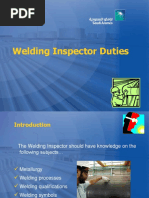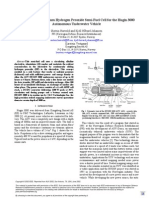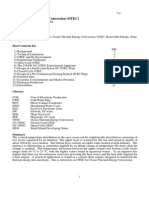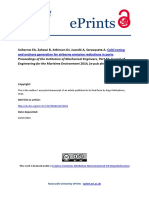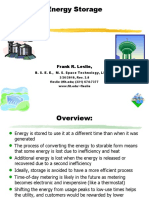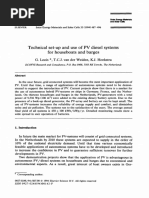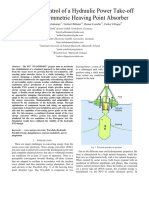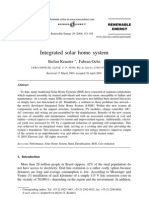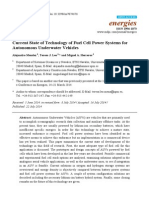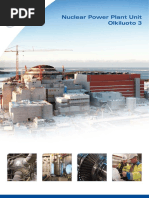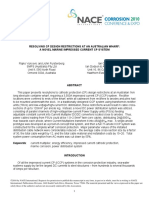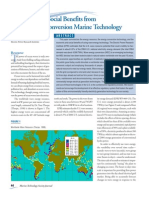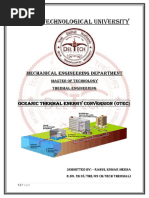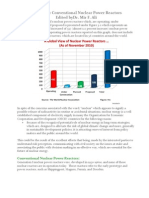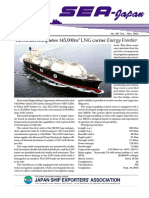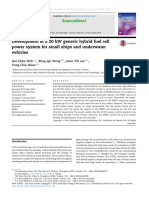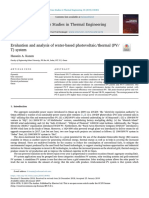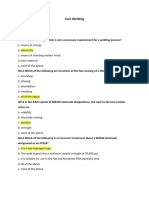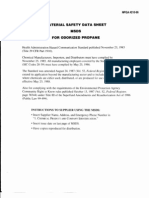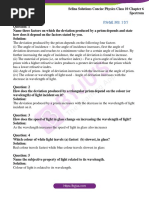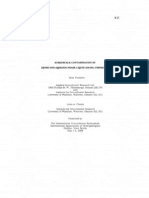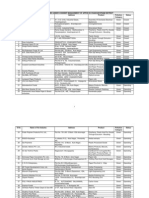0 ratings0% found this document useful (0 votes)
91 viewsPower Sources For Autonomous Underwater Vehicles: Øistein Hasvold, Nils J. Størkersen, Sissel Forseth, Torleif Lian
Power Sources For Autonomous Underwater Vehicles: Øistein Hasvold, Nils J. Størkersen, Sissel Forseth, Torleif Lian
Uploaded by
mspetro89
Copyright:
© All Rights Reserved
Available Formats
Download as PDF, TXT or read online from Scribd
Power Sources For Autonomous Underwater Vehicles: Øistein Hasvold, Nils J. Størkersen, Sissel Forseth, Torleif Lian
Power Sources For Autonomous Underwater Vehicles: Øistein Hasvold, Nils J. Størkersen, Sissel Forseth, Torleif Lian
Uploaded by
mspetro0 ratings0% found this document useful (0 votes)
91 views8 pages89
Original Title
2480
Copyright
© © All Rights Reserved
Available Formats
PDF, TXT or read online from Scribd
Share this document
Did you find this document useful?
Is this content inappropriate?
89
Copyright:
© All Rights Reserved
Available Formats
Download as PDF, TXT or read online from Scribd
Download as pdf or txt
0 ratings0% found this document useful (0 votes)
91 views8 pagesPower Sources For Autonomous Underwater Vehicles: Øistein Hasvold, Nils J. Størkersen, Sissel Forseth, Torleif Lian
Power Sources For Autonomous Underwater Vehicles: Øistein Hasvold, Nils J. Størkersen, Sissel Forseth, Torleif Lian
Uploaded by
mspetro89
Copyright:
© All Rights Reserved
Available Formats
Download as PDF, TXT or read online from Scribd
Download as pdf or txt
You are on page 1of 8
Journal of Power Sources 162 (2006) 935942
Power sources for autonomous underwater vehicles
istein Hasvold
, Nils J. Strkersen, Sissel Forseth, Torleif Lian
Forsvarets forskningsinstitutt, FFI (Norwegian Defence Research Establishment), P.O. Box 25, N-2027 Kjeller, Norway
Received 9 February 2005
Available online 1 September 2005
Abstract
The paper addresses the general requirements for power sources for AUVs, including battery and semi-fuel cell design and safety considera-
tions. The focus is on the last AUVin the HUGINfamily: the HUGIN1000 mine reconnaissance system. For this AUV, FFI recently developed
a pressure tolerant lithiumion battery based on commercially available polymer cells. The Royal Norwegian Navy has been operating HUGIN
1000 since February 2004.
2005 Elsevier B.V. All rights reserved.
Keywords: Underwater; Vehicles; HUGIN family; Battery; Semi-fuel cell; Fuel cell
1. Introduction
FFI has been developing autonomous underwater vehi-
cles (AUV) for more than a decade. During this period
we have been using many different power sources: mag-
nesium/dissolved oxygen seawater semi-fuel cell [1,2],
valve-regulated leadacid (VRLA), nickel/cadmium (NiCd),
nickel/metal hydride (NiMH), alkaline aluminium/hydrogen
peroxide semi-fuel cell (AlHP) [3,4], sealed lithium ion and
lithium polymer. Most of this work has taken place in close
cooperation with Kongsberg Maritime, which is also the
commercial producer of the HUGINclass autonomous under-
water vehicles (AUV) [5]. HUGIN is an acronym for High
precision Unmanned Geosurvey and INspection system. It is
also a name from Norse mythology: Hugin and Munin were
the two ravens that daily ew from Odins shoulders down to
the earth. After returning, they informed him on what was
going on in the world. This was an advanced form of rapid
environmental assessment (REA), one of the primary tasks
of naval AUVs besides mine counter measures (MCM). A
typical HUGIN AUV is equipped with sensors for seabed
mapping and imaging, a sub-bottom proler for subsurface
characterization, acoustic links for communication and nav-
Corresponding author. Tel.: +47 63807534; fax: +47 63807509.
E-mail address: oistein.hasvold@f.no (. Hasvold).
igational sensors for accurate positioning. The requirements
for civilian and military AUVs are similar, and the HUGIN
AUVdevelopment is one of the rare cases where non-military
industrial interests have nanced the initial development. In
February 2004, however, the rst military AUV, HUGIN
1000, was delivered to the Royal Norwegian Navy for oper-
ation from the mine-hunting vessel KNM Karmy.
2. Alkaline aluminium/hydrogen peroxide
semi-fuel cell
The civilian AUVHUGIN3000 is operated commercially
all over the world by different companies. One company,
C&C Technologies, has accumulated more than 40,000 km
of line survey with their HUGIN3000 [6]. In a routine seabed
mapping operation, HUGIN 3000 follows the seabed at a
constant height above the seabed. It operates at 4 knots down
to a sea depth of 3000 m and has an endurance of up to 60 h
with a typical sensor suite and all sensors operating (side-scan
sonar, multi-beam echo sounder, sub-bottom proler, etc.).
An alkaline aluminium hydrogen peroxide semi-fuel cell
developed at FFI [7] powers HUGIN 3000. The cell stack is
composed of six serially connected cells and uses circulating
electrolyte (7 M KOH). Hydrogen peroxide is added con-
tinuously to the electrolyte in order to keep a constant (but
low) concentration of hydrogen peroxide and oxygen in the
0378-7753/$ see front matter 2005 Elsevier B.V. All rights reserved.
doi:10.1016/j.jpowsour.2005.07.021
936 . Hasvold et al. / Journal of Power Sources 162 (2006) 935942
electrolyte. A DC to DC converter generates a stable system
voltage of 30 V. The stackvoltage is typically9 V. This system
is under constant development and at present, the energy con-
tent is up to 50 kWh per rell of electrolyte (anodes are only
changed every second or third dive), giving the vehicle an
endurance of typically 60 h at 4 knots and all sensors work-
ing [8]. The corresponding energy density is 100 Wh kg
1
based on total system weight. This power source has been
described in detail in ref. [4]. The basic chemistry of the sys-
tem is described in [3]. Compared to other power sources for
AUVs, the main advantages of the Al/HP power source are
high energy density, low weight in water and that it operates
at ambient pressure without the weight penalty of a pressure
hull. In addition, it allows rapid mechanical recharge, typical
deck time is only a few hours and usually determined by the
time needed to unload the data from the vehicle and not by
the time used to recharge the battery. Fig. 1 shows the Al/HP
cell stack and Figs. 2 and 3 typical system data during opera-
Fig. 1. The Al/HP semi-fuel cell stack with gas separation system and con-
nections.
Fig. 2. Temperatures of battery electrolyte, buffer battery, battery control container and seawater during a dive in the Norwegian Sea; sea depth 0980 m.
Fig. 3. System voltage, system current and stack voltage vs. time.
. Hasvold et al. / Journal of Power Sources 162 (2006) 935942 937
Table 1
HUGIN3000: typical operationis constant velocity(ca. 4knots) andconstant
height (typically 40 m) above the seabed
Displacement (m
3
) 2.4
Dry weight (kg) 1400
Length (m) 5.35
Diameter (m) 1.00
Maximum operation depth (m) 3000
Endurance 60 h at 4 knots, all sensors operating
Table 2
Weight and performance of the HUGIN 3000 AlHP semi-fuel cell
Aluminium anodes for six cells (kg) 60.8
185 liter 7 M KOH (kg) 238.7
70 liter 50% HP (kg) 84
Sum active components (kg) 383.5
Battery box complete with cathodes (kg) 82.4
Hydrogen peroxide systems (kg) 6
Sum battery weight (kg) 472
Battery weight in water (kg) 148
Nominal system voltage (V) 30
Nominal system energy (clear electrolyte) (kWh) 50
Maximum continuous system power (kW) 1.2
tion. With a net power output of 1 kW, heat production in the
cell stack is approximately 2 kW, resulting in a temperature
increase of approximately 18
C above the seawater temper-
ature. In normal operation, HUGIN 3000 operates with clear
electrolyte, but if precipitation of aluminium hydroxide is
allowed, a major increase in energy output can be achieved.
Operation with precipitation does however require disassem-
bly and cleaning of the cell stack after discharge. Table 1
shows some gures for the HUGIN 3000 AUV and Table 2
technical data for the power source.
The main disadvantage of the AlHP semi-fuel cell sys-
tem is the logistics requirements. The mother vessel must be
equipped with systems for safe handling of 7M KOH, 50%
HP and for the collection of spent electrolyte. In addition, the
crew must be well trained in order to handle the chemicals in
a safe manner. Typically, the AUV is operated from two con-
tainers that contain systems for launch and recovery, AUV
maintenance, handling of chemicals and water purication.
3. NiCd, NiMH and lithium ion
Power sources for AUVs typically have a fairly constant
load and specic power is moderate. Typical discharge rate is
less than C/5 for survey AUVs. Compared to batteries devel-
oped for electric vehicles (EV) this rate of discharge rate is
modest. The rate of charge however should be high in order to
reduce deck time. Historically, EV battery technology devel-
opment has given the AUVs a free ride. High rate capability
and safety are not necessarily compatible, so rate capability
above what is needed should be avoided.
The AUV HUGIN 1 was commissioned in 1995 and is
still in use for sensor and system development by FFI. It was
initially equipped with prismatic valve regulated Hoppecke
NiCD FNC 90 Ah cells. The battery was assembled in two
tubular aluminium containers with one string in each con-
tainer (25S 2P conguration). The charge controller for
this battery was based on industrial components (Advantech
ADAM 3000 series) and PC software. The battery manage-
ment unit (BMU) contained sensors for current, temperature
and voltage measurements, and the string voltage measured
directly and in ve steps of 6 V nominal (each string was
divided in ve) in order to detect faulty cells easier. A watch-
dog terminated the charge in case of computer failures or
hangs.
In 1998, HUGIN 1 was updated with Sony US26600
lithium ion cells in a 40P 8S conguration and the BMU
redesigned. The parallel connections were made via polymer
fuses (PPTC, polymer positive temperature coefcient resis-
tors). This new battery used only one battery container and
the ret made it possible to use the other battery container for
sensor electronics. In 2003, the Sony cells were exchanged
with AGM ICR34600 D-cells in a 34P8S conguration.
Our experience so far is that hermetically sealed cells in
pressure hulls perform well. The US26600 cells were down
to 70% of their original capacity after 5 years of use and
occasional abuse (discharge below the recommended cut-
off). A hardware shut-down device could have avoid this
abuse. Given the signicant cost of the battery, a low cell
voltage hardware disconnect is part of the BMU in later
AUV designs. Heat production during charge or discharge
is insignicant and the development of differences in the
parallel block capacities is very slow, making manual block
balancing (once every 2 year) acceptable.
Compared to lithium ion, nickel metal hydride (NiMH)
has lower gravimetric energy density, but is much cheaper.
During development of HUGIN3000, we used a 4 kWh 8.4 V
NiMH battery (12P7S Sanyo HRD) as a substitute for the
Al/HP semi-fuel cell stack. The AUV NUI Explorer (former
HUGIN II) was also using NiMH in a pressure vessel.
4. Pressure tolerant batteries
The weight of a pressure hull increases with design depth.
As a consequence, the amount of energy that can be con-
tained in a vehicle with neutral buoyancy decreases with
design depth. Obviously battery containers should be as light
as possible, and design and choice of materials is a science
by itself. An alternative, especially for deep diving vehicles
is to make a battery that operates at ambient pressure, but is
electrically insulated from the seawater.
FFI did some encouraging experiments with polymer
lithium ion cells in the late 90 s [9]. Fig. 4 shows that the
cell voltage is only marginally affected by pressure during
discharge. Others also made similar experiments, such as
Bluen Robotics [10].
For solid (and liquid) materials, the compressibility is very
low, thus a large increase in pressure is necessary in order to
938 . Hasvold et al. / Journal of Power Sources 162 (2006) 935942
Fig. 4. Discharge of a lithium ion polymer cell moulded in polyurethane and exposed to pressure variations during discharge. Nominal capacity 3.8 Ah, vendor
B. Discharge current C/5, room temperature. Upper curve, cell voltage and lower curve pressure (3.0 equals 300 bar or 3000 m sea depth).
achieve a signicant change of the dimensions. For a com-
posite material, such as a polymer cell, the result is that the
hydrostatic pressure must be very high in order to develop dis-
placements that may destroy the cell. In presence of a void,
however, even a low pressure may result in deformations that
may lead to a cell failure.
In lithiumion cells, the volume of the active masses varies
with the temperature, the pressure and the state of charge. In
hermetically sealed cells, a small void inside the cell allows
volume changes to occur with only minor change in the inter-
nal cell pressure and normally without a signicant change
in the external dimensions of the cell. In a polymer cell, how-
ever, the thickness of the cell increases with state of charge.
An obvious consequence of this dimensional change is that
cell assemblies must be resilient.
Initially, cells fromtwovendors (AandB) were purchased,
moulded into polyurethane, charged at normal pressure and
dischargedat 300 bar, correspondingtoa sea depthof 3000 m.
Cells from vendor A developed gas internally, ballooned
and further experiments were terminated. This ballooning
was not related to the pressure testing. The results with
cells from vendor B were encouraging and it was decided
to develop a pressure tolerant battery based on these cells
(Figs. 5 and 6). Later, we have also been using cells from a
third vendor (C) with good results.
5. General requirements for an AUV for MCM and
REA
The Norwegian mine counter measure (MCM) eet is
based on surface effect ships (SES). These ships are fast,
and as most catamarans they have a large deck area, but their
performance is very sensitive to weight. The naval energy
carrier is diesel and electricity is generated on-board from
diesel. In an AUV with mine reconnaissance and REA as
Fig. 5. Discharge energy/Wh vs. cycle number for two blocks made from cells from vendor B. Charge: C/5 to 4.20 V, terminated at C/10. Discharge C/5
terminated at 3.00 V. Equipment: Diagatron BTS 600. The increase in capacity at approximately cycle 250 correlates with a recalibration of the equipment.
. Hasvold et al. / Journal of Power Sources 162 (2006) 935942 939
Fig. 6. Block energy vs. cycle number for a polymer block charged at normal pressure and discharged at normal pressure or at 300 bar. Charge and discharge
as in Fig. 5. Cells from vendor B.
primary requirements, AlHP was considered unpractical and
primary lithium too expensive for routine use. This left us
with two high energy density options: lithium ion batteries
in a pressure hull or lithium polymer batteries working at
ambient pressure. The design depth is only 1000 m, but for a
MCM AUV, robustness to shock and vibration is mandatory
and the requirements severe. The moulded blocks have excel-
lent resistance to shock and vibration and it was decided to
develop a pressure tolerant polymer battery for HUGIN1000.
6. HUGIN 1000 battery module
The battery module was to be built fromblocks of parallel-
connected polymer cells. Block size was ca 40 Ah. To reduce
or eliminate the danger of electric shock, the battery volt-
Fig. 7. The last AUV in the HUGIN family: the HUGIN 1000 mine recon-
naissance system. The Royal Norwegian Navy has been operating HUGIN
1000 with polymer batteries since February 2004.
age should be less than 50 V in order to be non-hazardous
and two men should be able to carry the battery module.
Thus, each battery module was composed of 36 blocks in
a 3P12S conguration. Assuming polymer cells with 4.2 V
charge voltage and 3.0 Vend of discharge, the battery voltage
range was from 50.4 V down to 36.0 V. The AUV should be
able to operate from one battery module only.
Typical load is 700 W at a speed of 4 knots, peak load
ca. 2 kW at 6 knots. HUGIN 1000 shown in Fig. 7 may be
operated with up to three lithium polymer batteries, each
of approximately 5 kWh at C/5, giving ca. 20 h at 700 W.
Each battery measures 1540 mm248 mm140 mm and
weights ca. 83 kg. An optional primary battery in a pressure
hull may give a signicant increase in endurance.
7. Battery safety
Even though some polymer cells passed the UN test [11]
withrespect toshort circuit andovercharge, this was nolonger
the case for the parallel-connected cells in a block. This may
simply be because of the reduced surface to volume ratio
in the block. In blocks, short circuit tolerance was achieved
through the use of polymer fuses on each cell, but this did not
prevent an intensive re resulting from overcharge. Thus, the
BMU is a very important piece of safety equipment. Some
requirements to the battery were:
Internal short in one polymer cell should be tolerated
polymer fuses.
Fire in one block should not spread through the battery
rewalls.
Cables should not short if heatedglass insulation on
power leads.
Efcient heat transfer to the surroundingssilicone oil.
Rigid battery case even if the battery is burningtitanium
battery box.
940 . Hasvold et al. / Journal of Power Sources 162 (2006) 935942
Firewalls were made from syntactic foam integrated in
the blocks and from thin stainless steel sheets. Silicone oil
has a ash point above 320
C, is very difcult to ignite
and is non-toxic. As long as the AUV is in the water, re
is not a safety issue, but during storage and charge a battery
re may have severe consequences. The smoke is poisonous,
containing HF and other decomposition products from the
battery and the polyurethane plastics used for moulding. A
re is ideally best avoided, but possible to ght with a trained
crew using standard re ghting (water) and protective
equipment.
A new BMU based on a micro-controller was developed
for the battery. The BMU measures all cell voltages, the bat-
tery temperature and the battery current. It also keeps track
of charge in and out of the battery, cycle count, production
number, etc. During charge the BMU reports these values
to the charge PC that controls the charger current and volt-
age. Normal charge is constant current until a cell voltage
of 4.20 V is reached, then constant voltage until the charge
current goes below a set value. If any cell voltage, temper-
ature or current is outside the allowed range (3.004.25 V)
the BMU disconnects the battery. If the charge PC measures
any fault condition, the charge will be terminated. A separate
set of analogue circuits also senses the cell voltages and dis-
connects the battery if a voltage reading outside the allowed
window is read. The analogue circuits have larger allowable
voltage windows (2.704.30 V) and should only operate if
the digital circuit fails. The analogue circuit is connected to
the battery at all time. The BMU also contained circuits for
battery balancing by bypassing part of the charge current
from those cells that had the highest voltage reading during
charge.
During operation of the BMU, current, cell voltages and
battery temperatures were transferred to the charge PC dur-
ing charge and to the AUV control processor (CP) during
discharge. The data were stored.
8. Hydrogen fuel cells
A fuel cell based on compressed hydrogen in composite
cylinders and pure oxygen is an interesting alternative for
underwater vehicles. The system as such is bulky, but the
low weight of composite cylinders can make the total per-
formance of a deep diving AUV very high as the hydrogen
storage canhave the additional functionof buoyancycompen-
sation [9]. A typical AUV for deep-sea survey operation may
contain 300600 l of syntactic foam in order to achieve neu-
tral buoyancy. Foam density is approximately 500 kg m
3
,
increasing with design depth. This density is comparable to
a state of the art carbon bre composite gas bottle lled with
hydrogen with a working pressure of 450 bar. Although it
should be recognized that the rating for external pressure is
signicantly less than the rating for internal pressure, car-
bon bre composites is an excellent material for pressure
vessels. The land-based interest in fuel cells has resulted in
a number of commercially available and ofcially approved
composite cylinders for hydrogen storage. This is not the
case for compressed oxygen, but here the option of using
hydrogen peroxide as an oxygen carrier may be used as an
alternative.
Off-base operation of fuel cell powered survey AUVs also
requires a minimum size of the mother vessel as the weight
andvolume of the on-boardsystems (electrolyser or hydrogen
bottles andhighpressure pumpfor hydrogenproduction) may
be fairly high.
There is at present a large interest in hydrogen/oxygen
fuel cells for underwater use. The German AUV DeepC [12]
as well as the Japanese AUV Urashima [13] are designed
with hydrogen/oxygen fuel cells. The technology is mature
for large submarines and space application and a miniatur-
ization of the systems for commercial application in AUVs
is expected.
9. Discussion
In Table 3, some power sources that have been used in
AUVs to date (or in progress of development in conjunction
with a specic AUV program) are compared. The following
assumptions have been made in the performance calculations.
AUV volume is 1.2 m
3
, with 25% of the total volume
allocated to the power source. It is assumed that this vol-
ume is kept neutrally buoyant by using syntactic foam with
a density of 550 kg m
3
and aluminium (Al 6082 T6) as the
pressure container material. Maximum design depths used
in the calculations are 1000 and 3000 m. For the endurance
calculations, a propulsion power of 350 W (corresponding to
constant velocity of approximately 4 knots) and a hotel load
of 400 W have been used.
In the low performance end, we nd the conventional
leadacid and Ni-based rechargeable technologies, which are
simple, benign and low-cost systems, often used on AUVs
for testing and experimentation. A great leap in performance
came with the introduction of rechargeable lithium ion bat-
teries. They are simple to use and have good cycle life,
thereby providing acceptable overall life cycle cost. Safety
is acceptable, if the proper best practices in battery design
and operation are employed. Today, they are replacing silver
zinc as the workhorse of the AUV community.
Semi-fuel cells based on aluminium metal anodes, hydro-
gen peroxide and alkaline electrolytes have been used by
commercial offshore industries AUVs since 1998. These
systems operate at ambient pressure and are therefore very
attractive in deep-water systems (e.g. 3000 m). Turn-around
time is low (less than four hours) and endurance is high (60 h
in HUGIN 3000, which is a larger vehicle than the one used
in the calculations above). The system is fairly complex and
involves onboard infrastructure and logistics that requires
skilled personnel for operation.
Hydrogenoxygen fuel cells are now approaching matu-
rity in other applications (e.g. air independent propulsion for
. Hasvold et al. / Journal of Power Sources 162 (2006) 935942 941
Table 3
Typical performance gures of electrochemical power sources in a generic AUV of a total volume of 1.2 m
3
Technology Type Energy density (Wh/dm
3
) Endurance (h) Cost Logistics/maintenance
Leadacid Rechargeable 1020 48 Low Low
NiCd/NiMH Rechargeable 1030 412 Low Low
Alkaline batteries (heated to +45
C) Primary 1030 412 Low/high Medium
Silverzinc Rechargeable 3050 1220 High Medium
Lithium ion (D-cells) Rechargeable 4070 1628 Medium Low
Lithium polymer (poach) Rechargeable 5075 2330 Medium Low
Aluminiumoxygen Semi-fuel cell 8090 3236 Medium High
Hydrogenoxygen Fuel cell 100+ 40+ Medium High
Lithium batteries Primary 100150 4060 High Low
conventional submarines), but are only in its infancy when it
comes to AUVs. Fuel cells have a fair potential in the future,
in particular in the larger AUVs.
Primary lithiumbatteries provide very high energy density
and endurance, but operating costs and battery safety are of
great concern. This will limit the use of primary Li batteries
to applications that are valued important enough to accept the
high risk and cost levels [14].
Seawater batteries, in particular, batteries that exploit the
oxygen in the ocean, have also been used in AUVs, however
these systems have not been included in Table 3. The reason
for this is that the design of the battery is so tightly inte-
grated with the vehicle itself that it is not possible to comply
directly with the initial assumptions. However, the general
performance attributes of seawater batteries are a very long
endurance capability, but a low power (load) capability that
limits the application to a low power sensor suite [2].
Compared to commercially available pressure tolerating
polymer batteries, the energy density of the HUGIN1000 bat-
tery module is modest (ca. 60 Wh kg
1
). This is partly caused
by the use of syntactic foamrewalls and partly by the use of a
metal battery container that keeps its shape in a re. Firewalls
made from buoyancy materials do not however decrease the
systemenergy, as they contribute to the buoyancy of the vehi-
cle. Until we have more experience with these batteries, the
penalty of using heat and corrosion resistant materials in the
battery box will be accepted. The same is the cause for using
silicone oil: compared to mineral oil, the density is higher and
it is more compressible, increasing the difculties with buoy-
ancy control of the vehicle. With increased courage based on
more experience, lighter and more ammable materials may
be used in the future.
The safety considerations with aluminium semi-fuel cell
are related to the handling of the chemicals, and to the small
amounts of hydrogenandoxygenpresent inthe gas separation
system of the AUV. The energy in this volume of explosive
gas is too small to be a threat to a properly equipped crew or
to the mother vessel.
Similar considerations may be applied to a fuel cell system
where an explosion or re may take place in the fuel cell
pressure vessel, releasing a moderate amount of energy. The
fuel as such, should not be a problem for a surface ship with
well-ventilated AUV handling facilities.
Primary lithiumbatteries are expensive and their behavior
under abuse conditions is a safety concern. For some appli-
cations, however, the high range capability associated with
their high specic energy outweighs other factors, such as
cost, and the unpleasant behavior under abusive conditions.
10. Conclusion
The power source is an important performance-
determining component of any AUV and its choice should
be done early in the design phase. Depending on the size and
use of the AUV, different power sources should be used. For
small AUVs with shallow design depth, primary lithium and
lithium ion working at normal pressure are preferred. As the
design depth is increased, pressure tolerant lithium ion gets
an edge. For larger AUVs designed for deep-water opera-
tion, pressure tolerant semi-fuel cells and hydrogen/oxygen
fuel cells that can use their gas storage as part of the AUV
otation gives the best performance.
References
[1] . Hasvold, A magnesium-seawater power source for autonomous
underwater vehicles, in: A. Attewell, T. Keyly (Eds.), Power Sources,
vol. 14, 1993, pp. 243255.
[2] . Hasvold, T. Lian, E. Haakaas, N. Strkersen, O. Perelman, S.
Cordier, CLIPPER: a long-range, autonomous underwater vehicle using
magnesium fuel and oxygen from the sea, J. Power Sources 136 (2004)
232239.
[3] . Hasvold, K.H. Johansen, O. Mollestad, N. Strkersen, The alka-
line aluminium/hydrogen peroxide power source in the HUGIN II
unmanned underwater vehicle, J. Power Sources 80 (1999) 254260.
[4] . Hasvold, K.H. Johansen, K. Vestgaard, The alkaline aluminium
hydrogen peroxide semi-fuel cell for the HUGIN 3000 autonomous
underwater vehicle, in: Proceedings of the 2002 Workshop on
Autonomous Underwater Vehicles, San Antonio, TX, June 2021,
2002, pp. 8994.
[5] Kongsberg Maritime, www.km.kongsberg.com.
[6] C&C Technology, www.cctechnol.com.
[7] . Hasvold, US Patent US 6,573,008 B1.
[8] Geoconsult, www.geoconsult.com.
[9] . Hasvold, N. Strkersen, Electrochemical power sources for
unmanned underwater vehicles used in deep sea survey operations,
J. Power Sources 96 (2001) 252258.
942 . Hasvold et al. / Journal of Power Sources 162 (2006) 935942
[10] K. Streitlien, J. Scott Willcox, Pressure-Tolerant Batteries for
Autonomous Undersea Application, see: www.bluenrobotics.com.
[11] Recommendations on the TRANSPORT OF DANGEREOUS
GOODS, Manual of Tests and Criteria, ST/SG/AC.10/11/Rev3,
Amendment 1, United Nations, Geneva, New York, 2002.
[12] www.deepc-auv.de.
[13] www.jamstec.go.jp/jamstec-e/rov/auv ex1.html.
[14] N. Strkersen, . Hasvold, Power sources for AUVs, in: Proceedings
of the Science and Defence Conference, Brest, France, October 19,
2004.
You might also like
- Yi Chao Paper On PCM Argo FloatDocument4 pagesYi Chao Paper On PCM Argo FloatAnubhav SharmaNo ratings yet
- Sabre 4000: Operators ManualDocument130 pagesSabre 4000: Operators ManualLuis Landeros100% (1)
- ARAMCO-Welding Inspector DutiesDocument73 pagesARAMCO-Welding Inspector DutiesAdilMunir100% (5)
- Chloro Alkali ProjectDocument58 pagesChloro Alkali ProjectIbrahim Ebu100% (2)
- The Alkaline Aluminium Hydrogen Peroxide Semi-Fuel Cell For The Hugin 3000Document6 pagesThe Alkaline Aluminium Hydrogen Peroxide Semi-Fuel Cell For The Hugin 3000Luthfi RaisNo ratings yet
- (2004) Oistein Hasvold - CLIPPER - A Long-Range, Autonomous Underwater Vehicle Using Magnesium Fuel and Oxygen From The SeaDocument8 pages(2004) Oistein Hasvold - CLIPPER - A Long-Range, Autonomous Underwater Vehicle Using Magnesium Fuel and Oxygen From The SeaK A ThomasNo ratings yet
- ScienceDocument8 pagesScienceSinan DemirNo ratings yet
- OTECbyVega With Photos PDFDocument23 pagesOTECbyVega With Photos PDFFahmiRosdianaNo ratings yet
- Cold Ironing and Onshore Generation For Airborne Emission ReductionsDocument34 pagesCold Ironing and Onshore Generation For Airborne Emission ReductionsyoungfpNo ratings yet
- OTEC Technology-A World of Clean Energy and Water: R. MageshDocument6 pagesOTEC Technology-A World of Clean Energy and Water: R. Mageshharsh9974134269No ratings yet
- (2001) Hasvold Electrochemical Power Sources For AUVDocument7 pages(2001) Hasvold Electrochemical Power Sources For AUVK A ThomasNo ratings yet
- Energy Storage: Frank R. LeslieDocument27 pagesEnergy Storage: Frank R. LeslieRima SadekNo ratings yet
- Acondicionamieno Técnico Solar para Barcazas. InglésDocument10 pagesAcondicionamieno Técnico Solar para Barcazas. Inglésjuai titiNo ratings yet
- A Strategy For Sizing and Optimizing The Energy System On Long-Range AUVsDocument12 pagesA Strategy For Sizing and Optimizing The Energy System On Long-Range AUVsChicheNo ratings yet
- Sizing The Energy System On Long-Range AUVDocument6 pagesSizing The Energy System On Long-Range AUVChicheNo ratings yet
- 2012 Design and Control of a Hydraulic PTO for Heaving Point AbsorberDocument16 pages2012 Design and Control of a Hydraulic PTO for Heaving Point AbsorberISQNo ratings yet
- Solar Renewable EneggyDocument12 pagesSolar Renewable EneggysamyektapolNo ratings yet
- Safety-Related Studies On Hydrogen Production in High-PressureDocument12 pagesSafety-Related Studies On Hydrogen Production in High-Pressurejorge bustos100% (1)
- OTEC Summary Aug 2012Document33 pagesOTEC Summary Aug 2012Robie TrieoNo ratings yet
- A Review of Oscillating Water ColumnsDocument12 pagesA Review of Oscillating Water ColumnsCristobal Michelangelo FernaandesNo ratings yet
- Etep 582Document24 pagesEtep 582epestudentNo ratings yet
- (A) Site Selection For Hydroelectric Power PlantDocument21 pages(A) Site Selection For Hydroelectric Power Plantvivaanrv127No ratings yet
- The Ports As Smart Micro-Grids: Development PerspectivesDocument6 pagesThe Ports As Smart Micro-Grids: Development Perspectivesnkor6574No ratings yet
- A 10-GW Pulsed Power Supply For HPM SourcesDocument8 pagesA 10-GW Pulsed Power Supply For HPM SourcesforfreeNo ratings yet
- Energies: Current State of Technology of Fuel Cell Power Systems For Autonomous Underwater VehiclesDocument18 pagesEnergies: Current State of Technology of Fuel Cell Power Systems For Autonomous Underwater VehiclesmspetroNo ratings yet
- Nuclear Power Plant Unit Olkiluoto 3Document64 pagesNuclear Power Plant Unit Olkiluoto 3Nestor RomeroNo ratings yet
- Nuclear Power Plant Unit Olkiluoto 3Document64 pagesNuclear Power Plant Unit Olkiluoto 3Patrick LaffontNo ratings yet
- Paper NoDocument11 pagesPaper NoSuresh DNo ratings yet
- Wave EnergyDocument14 pagesWave EnergyMohd Qazar YusopNo ratings yet
- Mtechres PPT U 3 C 3Document15 pagesMtechres PPT U 3 C 3MounikaNo ratings yet
- JPS23-183 - Ten-Megawatt Load-Levelling Lead Acid BatteryDocument10 pagesJPS23-183 - Ten-Megawatt Load-Levelling Lead Acid Batterycarlosalberto.camargoNo ratings yet
- Nuclear Safety HistoryDocument26 pagesNuclear Safety HistorycaffiNo ratings yet
- 13 ExMagazine Web en Nav Adi System Ensures Safety of Drilling RigsDocument4 pages13 ExMagazine Web en Nav Adi System Ensures Safety of Drilling Rigsrocket-vtNo ratings yet
- Energies 08 11470Document23 pagesEnergies 08 11470K. ManjericãoNo ratings yet
- Non-Isentropic Study of A Closed-Circuit Oscillating-Water-Column Wave Energy ConverterDocument14 pagesNon-Isentropic Study of A Closed-Circuit Oscillating-Water-Column Wave Energy ConverterSthefanoNo ratings yet
- Ultra High-Voltage Gas-Insulated Switchgear - A Technology MilestoneDocument24 pagesUltra High-Voltage Gas-Insulated Switchgear - A Technology MilestoneSa'dun ArifNo ratings yet
- Performance Assessment of A 2 DOF GDocument13 pagesPerformance Assessment of A 2 DOF G6m24c772bsNo ratings yet
- Ocean Thermal Energy Conversion (OTEC)Document28 pagesOcean Thermal Energy Conversion (OTEC)Sehati FisikaNo ratings yet
- Power Cycling Test Circuit For Thermal Fatigue Resistance Analysis of Solder Joints in IGBTDocument10 pagesPower Cycling Test Circuit For Thermal Fatigue Resistance Analysis of Solder Joints in IGBTtolentino.jason1222No ratings yet
- Electricity Generating Device Through Wave Oscillation: (Review of Related Literature)Document5 pagesElectricity Generating Device Through Wave Oscillation: (Review of Related Literature)Jazz DungaranNo ratings yet
- MP2017F - Reveillere CAESnewbeginning v2 PDocument13 pagesMP2017F - Reveillere CAESnewbeginning v2 PAndrea La FiuraNo ratings yet
- Delhi Technological University: Mechanical ENGINEERING DepartmentDocument23 pagesDelhi Technological University: Mechanical ENGINEERING DepartmentRahulJaredaNo ratings yet
- Chapter04: Conventional Nuclear Power Reactors Edited Bydr. Mir F. AliDocument8 pagesChapter04: Conventional Nuclear Power Reactors Edited Bydr. Mir F. AliDr. Mir F. AliNo ratings yet
- Modeling Alkaline Electrolyzers 2003 Int J of Hydrogen EnergyDocument13 pagesModeling Alkaline Electrolyzers 2003 Int J of Hydrogen Energyadrian_63No ratings yet
- Renewable EnergyDocument14 pagesRenewable EnergyMounikaNo ratings yet
- Li On Newest EnergyDocument7 pagesLi On Newest EnergyJonathan NandhikaNo ratings yet
- Ocean Thermal Energy ConversionDocument17 pagesOcean Thermal Energy ConversionVamsi Pelluru100% (1)
- Unu GTP 2009 11Document27 pagesUnu GTP 2009 11Adam IbnuNo ratings yet
- Sea 301Document6 pagesSea 301PetricaNo ratings yet
- WaveenergyscanDocument14 pagesWaveenergyscanChersey DoctorNo ratings yet
- EP 1 Final - 082908Document25 pagesEP 1 Final - 082908tuanphamNo ratings yet
- Development of A 20 KW Generic Hybrid Fuel Cell Power System For Small Ships and Underwater VehiclesDocument8 pagesDevelopment of A 20 KW Generic Hybrid Fuel Cell Power System For Small Ships and Underwater Vehiclesad.hjzhuNo ratings yet
- Recent Advances With UNSW Vanadium-Based Redox Ow BatteriesDocument8 pagesRecent Advances With UNSW Vanadium-Based Redox Ow Batteriesrfa940No ratings yet
- Technical Specification 1700Document10 pagesTechnical Specification 1700bourneremembersNo ratings yet
- Lecturenote - 923618598chapter 4Document34 pagesLecturenote - 923618598chapter 4Mohammed JemalNo ratings yet
- Power Plant EngineeringDocument11 pagesPower Plant Engineeringnickswap100% (1)
- Water Based PVT SystemDocument8 pagesWater Based PVT SystemArchak SinghNo ratings yet
- ACR700.Simulator - Manual.2009 10Document45 pagesACR700.Simulator - Manual.2009 10yaprak dönerNo ratings yet
- 3 Chemical ReviewsDocument37 pages3 Chemical ReviewsIvan Liviu IonNo ratings yet
- 07530867-PostPrintDocument15 pages07530867-PostPrintmac cloudNo ratings yet
- 37 Out of 50 Critical Minerals On Earth. HDocument7 pages37 Out of 50 Critical Minerals On Earth. HVinayakNo ratings yet
- Scientific American Supplement No. 819, September 12, 1891From EverandScientific American Supplement No. 819, September 12, 1891Rating: 1 out of 5 stars1/5 (1)
- Extract Your Own DNA at Home (Laganson-EOP1)Document3 pagesExtract Your Own DNA at Home (Laganson-EOP1)cristhel joyNo ratings yet
- Technical Datasheet: MBR Wastewater Treatment Pilot System For Water Recovery & ReuseDocument3 pagesTechnical Datasheet: MBR Wastewater Treatment Pilot System For Water Recovery & Reusekesavaganesan58No ratings yet
- Kuis 1 WeldingDocument21 pagesKuis 1 WeldingDimas Agung SetiajiNo ratings yet
- Calculation of Power Pumps On Otec Power Plant Ocean (Ocean Thermal Energy Conversion)Document14 pagesCalculation of Power Pumps On Otec Power Plant Ocean (Ocean Thermal Energy Conversion)Achmad Ilham BadruttamamNo ratings yet
- Tech Bulletin NPGA 210-96Document6 pagesTech Bulletin NPGA 210-96Edi Yahya S. NasutionNo ratings yet
- The Thermic Effect of Food A Review 1Document6 pagesThe Thermic Effect of Food A Review 1slbdn krmpcNo ratings yet
- Selina Spectrum by ByjusDocument23 pagesSelina Spectrum by ByjusOverRush AmareshNo ratings yet
- Chem 321 Exam 1 Study GuideDocument1 pageChem 321 Exam 1 Study Guideapi-245391028No ratings yet
- BODDocument15 pagesBODVansh JunejaNo ratings yet
- Factura para Liquidacion de Importacion 21-04-20Document2 pagesFactura para Liquidacion de Importacion 21-04-20Juan Pablo EstradaNo ratings yet
- Chapter 8 EpoxiesDocument62 pagesChapter 8 Epoxiesaslı aslanNo ratings yet
- Passivation: Corrosion ProtectionDocument51 pagesPassivation: Corrosion ProtectiondangminhNo ratings yet
- Strength Calculation For ThermowellsDocument5 pagesStrength Calculation For ThermowellsNymphetamine AnhNo ratings yet
- KSB LCC MDocument126 pagesKSB LCC MAlexander Alonso FernándezNo ratings yet
- Process and Product Audit Plan For Cup-Cone For The Year of 2018Document11 pagesProcess and Product Audit Plan For Cup-Cone For The Year of 2018অর্ঘ্য রায়No ratings yet
- Feenstra & Cherry 1988Document17 pagesFeenstra & Cherry 1988dnapl7613No ratings yet
- ME1251-Heat and Mass TransferDocument11 pagesME1251-Heat and Mass Transfermanoj kumar GNo ratings yet
- Lecture 21 Wire DrawingDocument13 pagesLecture 21 Wire DrawingprasannaNo ratings yet
- WL115 0117 PE4710 Water PipeDocument8 pagesWL115 0117 PE4710 Water PipeEdwin MariacaNo ratings yet
- Sno Name of The Industry Address Product Pollution Category Status List of Industries Under Consent Management of Appcb in Visakhapatnam DistrictDocument20 pagesSno Name of The Industry Address Product Pollution Category Status List of Industries Under Consent Management of Appcb in Visakhapatnam DistrictM Nagendra Reddy100% (3)
- Ratnamani - Manufacturing RangeDocument2 pagesRatnamani - Manufacturing RangeRenny DevassyNo ratings yet
- Pressure-Swing Reactive Distillation Process For Transesterification of Methyl Acetate With IsopropanolDocument3 pagesPressure-Swing Reactive Distillation Process For Transesterification of Methyl Acetate With IsopropanolMahesh ChantarkarNo ratings yet
- Materials ProjectDocument22 pagesMaterials ProjectGanga StudyNo ratings yet
- Science Quiz Bee Questions Grade 8 EasyDocument2 pagesScience Quiz Bee Questions Grade 8 EasyAizelle Taratara FaderoNo ratings yet
- Preparation and Study On Spectrum Characteristics of Sro.9, Ceosol Hf03 NanopowdersDocument4 pagesPreparation and Study On Spectrum Characteristics of Sro.9, Ceosol Hf03 NanopowdersIlse ArreolaNo ratings yet
- Hsslive Xii Chemistry Quick Notes Based On Scert Focus AreaDocument63 pagesHsslive Xii Chemistry Quick Notes Based On Scert Focus AreavaishnavNo ratings yet


